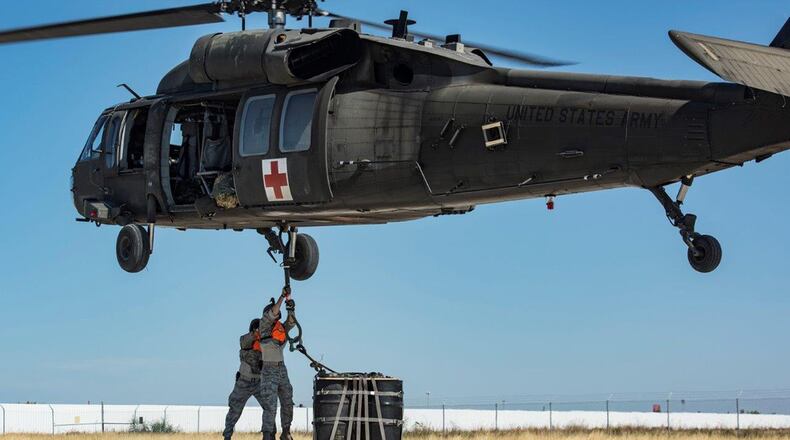The exercise scenario took place Nov. 18 at Martindale Army Airfield and simulated Airmen from the 26th Aerial Port Squadron receiving airdropped relief supplies from the 136th Airlift Wing in a remote part of Southwest Asia.
Second Lt. Adam Brewer, from the Air Force Life Cycle Management Center’s Business and Enterprise Systems Directorate, served as a member of the pathfinder team – the mission’s command and control cell – as the pick-up zone officer-in-charge.
“I conducted the placement and marking of the helicopter landing zone’s sling load points,” Brewer said. “This included measuring the spacing to ensure a safe distance between the UH-60 Black Hawks during their cargo hook-ups, and marking each point with day-glow panels so they could be easily identified from the air. I also supervised the safe execution of hook-ups at the lead sling load point.”
Brewer added that his duties included ensuring the members waited safely for the helicopter’s arrival, connected the cargo hook correctly and properly re-rigged the load after each turn.
During each hook-up, a two-person team stood beneath a helicopter while it hovered just overhead with one person holding the reach pendant and one person bracing that hook-up person. After connecting the load to the aircraft’s cargo hook and ensuring there were no snags or tangles in the line, the hook-up team moved out from under the aircraft to let the aircrew know the load was secured.
One of the hook-up team members, Senior Airman Justin King, 26th Aerial Port Squadron ramp operator, gave his observation of the day’s activities.
“We started the morning with an aircraft safety brief and rehearsals for our hookups,” King said. “Once things got going, the UH-60 Black Hawks came in two at-a-time, picking up the sling loads for a simulated relief supply drop-off. It was exciting to do something that is part of the aerial porter job, yet not part of our everyday norm. This was a great experience. Now we’ve all conducted live sling loads, and understand how they can benefit our future operations wherever we go.”
In keeping with its exercise name, Operation Alamo Evacuation witnessed the sling load evacuation of more than 36,000 pounds of cargo and the medical evacuation of 27 MEDEVAC actors.
Both of the leaders of the participating Texas Army National Guard and Air Force Reserve units emphasized that the day’s mission had value far beyond these tactical measures of accomplishment.
Offering his key leader perspective, Lt. Col. José Reyes, Texas Army National Guard, Company C, 2-149 Aviation commander, said that the training was beneficial for both developing technical proficiency and inter-service relationships.
“This was a tremendous opportunity for our units to work together,” Reyes said. “I challenged my staff to plan the most efficient training with aircrew and aircraft sequencing. Integrating the Air Force hook-up teams and pre-rigged loads improved the process, allowing faster iterations. We trained 12 pilots, six crew chiefs, and four medics. To put that many crews through training with only two aircraft in such a short amount of time speaks volumes for the value of inter-service cooperation.”
Brewer added that the exercise was a success.
“None of these units had ever worked together before today,” Brewer said. “Our flawless and safe execution is a testament to the detailed inter-service planning, mutual trust in each component’s competence, and leadership’s willingness to operationalize outside-the-box solutions. Today we demonstrated that Joint, Total Force activities provide amazing opportunities for learning and for expanding the capability of the Department of Defense.”
About the Author
